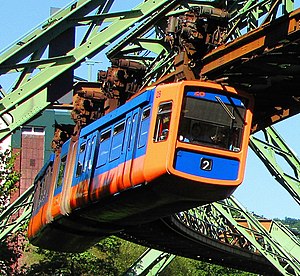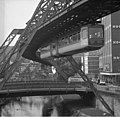WSW GTW 72
| GTW 72 | |
|---|---|
| Manufacturer: | MAN |
| Retirement: | since 2016 |
| Length: | 24,060 mm |
| Height: | 2729 mm (without chassis) |
| Width: | 2200 mm |
| Trunnion Distance: | 7645 mm |
| Bogie axle base: | 1280 mm |
| Smallest bef. Radius: | 9 m |
| Empty mass: | 22,175 kg |
| Service mass: | 35,500 kg |
| Top speed: | 60 km / h |
| Continuous output : | 4 × 50 kW |
| Acceleration: | 1.1 m / s² |
| Braking delay: | 1.2 m / s² |
| Wheel diameter: | 800 mm |
| Power system : | 600 V = |
| Power transmission: | Busbar |
| Number of traction motors: | 4th |
| Seats: | 43 + driver's seat |
| Standing room: | 156 |
| Classes : | 1 |
As a GTW 72 a is monorail - vehicle generation of Wuppertal municipal utility ( WSW ), respectively. The type designation is derived from the term G élénk T rubbed W agen and the year of commissioning of the first railcars from. Sometimes they are also called Bauart 1972 . The originally 28 three-part railcars were supplied by MAN between 1972 and 1975 and designed by Klaus Flesche , head of the MAN design office.
history
Installation
Towards the end of the 1960s, the Wuppertal suspension railway's fleet of vehicles was in increasingly poor condition: the cars that had been manufactured before the Second World War were around 50 years old, the cars from the immediate post-war period were made of materials that were not particularly resistant . The population of Wuppertal grew, during the construction of the Bergische Universität Wuppertal the city wanted to present itself as flourishing and dynamic. In keeping with this zeitgeist, a new series was ordered from MAN , which was to replace all of the various existing series. The first GTW 72 wagon reached Wuppertal on July 13, 1972. It was transported by rail to the Vohwinkel freight station , the three parts of the articulated railcar were lashed to three flat wagons . The short section from the train station to the workshop in Vohwinkel was covered with a heavy transport . The introduction of the new series did not attract much attention, only the functional design, the increased capacity and the plastic seats stood out. The maiden voyage took place on November 23, 1972 in the presence of Johannes Rau , then Science Minister of North Rhine-Westphalia , and Mayor Gottfried Gurland . On April 22, 1975, car 28 was also the last car to be delivered by freight train.
Retirement
Car 4 was scrapped after the accident in 1999 . Car 24 damaged in the accident in 2008 was repaired in the Vohwinkel workshop and has been ready for use again since December 2009. Cars 19 and 21 were postponed from the general inspection in June and July 2012 because of their poor general condition. Car 21 was placed in a parking space for official vehicles of the Wuppertal Zoo, which is not accessible to the public, and has meanwhile been damaged by vandalism . Car 19 was taken to the bus depot in NextBreck.
The GTW 72 have been replaced by the new suspension railway generation since 2016 . After the end of the exchange, the train control system will be converted to an ETCS system supplied by Alstom Transport Germany . Alstom received the order to equip the 31 new vehicles and the historic Kaiserwagens , but not the GTW 72 trains. Operation as a museum vehicle is not possible without train protection.
In August 2015, the Wuppertal public utility company announced that it would not scrap the GTW 72 vehicles after the arrival of the new vehicles, but instead offer 21 vehicles for sale and hand over three vehicles free of charge, provided that they remain in the area of the city of Wuppertal. A competition was announced for this purpose. One vehicle is to remain with the Wuppertal municipal utility; It is still open whether it will be reconditioned and equipped with the new train protection technology. For the vehicles to be sold, the WSW set a price of 4,000 to 5,000 euros for a railcar; this is the scrap value of the materials contained in the vehicle. In addition, the buyer incurs additional costs for transporting the wagons by low-loader , setting up a foundation at the installation site and obtaining the necessary building permit . If the train is standing, not hanging, the bogies and traction motors must be removed, as the car body is not designed for the corresponding pressure load. According to statements by the public utility company, 70 interested parties registered by the end of August, 35 of whom would be willing to finance transport and installation. The final sales decisions will be made by November 2015.
Car 8 left Wuppertal on July 7, 2016 and was set up at the star point of Vohwinkel's children's table. Then carriage 2 followed to Lindlar. On January 12, 2017, wagon 5 was also taken out of service and placed at the conveyor technology experience museum in Sinsheim. Car 10 was taken out of service on January 26th. He received the Sparkasse advertisement. This was set up at SC Breite Burschen Barmen in 1996. Subsequently, on February 8, 2017, car 3 was also retired. After car 3, the GTW 11 was withdrawn to the company "Schaeffler" on February 23, 2017, immediately afterwards the GTW 12 on March 9, 2017. This was temporarily delivered to Ronsdorf, but when the Barmen Clinic is ready in 2022, it will be there transported. GTW 14 was retired on April 27, 2017 - it went to the YMCA-Westbund. As the last wagon to date, the GTW 6 was transported to Gütersloh on May 11, 2017. Since the new GTW 10 touched the scaffolding on May 19, 2017, the delivery of the new wagons and the decommissioning of the old vehicles were paused until the problem was identified and a solution was found in August 2018. Since the GTW 72 were gradually due for a main inspection, GTW 7 (July 4, 2018), 9 (August 4, 2018) and 18 (approx. July 20, 2018) were shut down. GTW 13 had been out of service since November 2017, but received a small general inspection on July 27, 2018. GTW 15 also received a general inspection and returned to liner service at the end of August 2018.
Since the resumption of operation on August 1, 2019, no trains of this type have been on the road.
technology
A railcar consists of two end cars and a short middle section and has, in addition to the driver's seat, 48 seats and 156 standing places. The four electric motors in each railcar each have an output of 50 kilowatts and are controlled by four-quadrant actuators . The maximum acceleration is 1.1 m / s², the permissible deceleration is 1.2 m / s². The vehicle has a top speed of 60 km / h. The 24.06 meters long and 22,175 kilograms heavy railcars have four 1.3 meters wide double doors. The gross vehicle weight is 35,500 kilograms. The welded structure of the car body is checked regularly , during which parts of the interior fittings are also removed. A large part of the cars is now fully advertised .
gallery
Trivia
The series can be driven in the computer game suspension railway simulator 2013 .
The shape and color of the emoji 1f69f suspension railway from Twitter Inc. is based on the 1972 / GTW 72 design.
Web links
Individual evidence
- ↑ Andreas Boller: After 43 years there is a new suspension railway. In: Westdeutsche Zeitung. Retrieved November 15, 2015 .
- ↑ In the zoo is the terminus for the suspension railway train number 21 wz-newsline.de from July 5, 2012
- ↑ a b Dipl.-Ing. Joachim Ebmeyer, Dipl.-Ing. Christoph Deiss: Swiss bogie know-how for new suspension railway cars for the Wuppertal public utilities. In: Eisenbahntechnische Rundschau 9/2014, pp. 177–181.
- ↑ Peer Jacobsen: Tradition and Future: The Wuppertal Suspension Railway with ETCS Level 3 and TETRA. In: Eisenbahntechnische Rundschau 6/2014, pp. 54–57.
- ↑ The secret end of a suspension railway or a mistake is repeated. at njuuz.de , accessed on November 15, 2014.
- ↑ a b c Wuppertal gives away and sells suspension railway cars. Rheinische Post website , August 13, 2015, accessed on September 5, 2015.
- ↑ Wuppertal is giving away three suspension railways: the rest can be bought at t-online.de , August 13, 2015, accessed on September 5, 2015.
- ↑ a b bargain: suspension railway is in demand from Ludwigshafen to Bad Oeynhausen. Website of the Solinger Tagblatt, August 25, 2015, accessed on September 5, 2015.
- ↑ Voting participants - WSW competition: Three suspension railways for Wuppertal. In: neue-schwebebahn.de. Retrieved November 15, 2015 .
- ↑ Artur vom Stein: Who still needs a suspension railway? Website of the Westdeutsche Allgemeine Zeitung , August 12, 2015, accessed on September 5, 2015.
- ↑ The Wuppertal monorail: GTW72. Retrieved August 2, 2019 .





